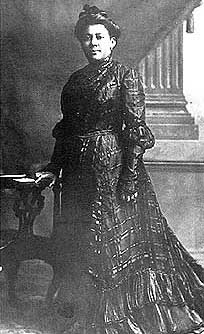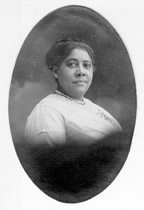Talbert Timeline
1866
1866a. Mary Burnett
Talbert (1866-1923) was born in Ohio as Mary Burnett. William
H. Talbert was born in Red Bluff, California to Robert Talbert
and Anna Harris Talbert.
1886b. At the
age of nineteen, Mary Burnett received a literary degree from
Oberlin College She moved to Little Rock, Arkansas.
1887
Burnett becames a high school principal. She
was the first Black high school principal in the state of Arkansas.
1891
1891. Mary Burnett
Talbert moves to Buffalo as the wife of wealthy businessman William
H. Talbert. Her only a child, a daughter Sarah May, was borna
year later.
1894 Mary B.
Talbert received a second degree. This gets little murky-- this
seems to be based on a provision that "Graduates in the former
Literary Course in 1887, or any previous year, may pursue further
study "in absentia," and receive, on examination, the
degree of Bachelor of Philosophy. [ref: UBarchivist
5/17/00]
Here is what is normally written here "In
1894 Mary Talbert becomes the first African American woman to
earn a Ph.D. from University of Buffalo." However, that statement
(even the degree) is under considerable doubt. Here's what I got
from the University at Buffalo archivist:
"I wish we could claim her as a UB
graduate but we can't. The story that she got a PhD from
UB has been around for some time, but I've checked the graduation
lists thoroughly for her name. During her time, UB consisted
of the schools of Medicine, Dentistry, Pharmacy and Law, with
liberal arts being added in 1913, and we didn't even give BA's
until the early 1920s. By the time of Talbert's death, we had
only granted two PhD's in total." [ref: UBarchivist
5/16/00]
Perhaps this Bachelor of Philosophy, as a
second degree, has in time mutated to "Doctorate of Philosophy"
and since she lived in Buffalo at the time, confusion transports
the degree from Oberlin to Buffalo.
Note records show Joseph
Robert Love earned an MD at UB sometime before 1880
1899. Talbert
is one of the founding members of the Phyllis Wheatley Club of
Colored Women. This remarkable group of women, the city's first
affiliate of the National Association of Colored Women's Clubs,
set an ambitious program of service to others in order to achieve
the NACW mission
1900. In November
1900, Mary Talbert, along with other members of the Phyllis Wheatley
Club of Colored Women, organized a protest rally at the Michigan
Avenue Baptist Church. They called on the Board of Managers of
the Pan American Exposition to include the Negro Exhibit,
an exhibit that presented the achievements of blacks since Emancipation,
in the upcoming Exposition. The group also advocated for the appointment
of a colored commissioner. Mary Talbert was proposed as a most
able and capable individual to represent the Negro community in
this position.
|
1901. In contrast
to the degrading Old Plantation Exhibition at the 1901 Pan American
Exposition, Buffalo's Black community lead by Mrs. John Dover,
James Ross, and Mary Talbert met at the Michigan Street Baptist
Church to promote a Negro Education Exhibit such as Booker T.
Washington's exhibit in Atlanta's 1895.
1905. W.E.B.
Dubois, John Hope, Monroe Trotter and 27 others met secretly
in the home of Mary B. Talbert. This began the Niagara Movement,
forerunner of the National Association for the Advancement of
Colored People (NAACP).
1910. While
serving as president of the Frederick Douglass Memorial Association,
Mary Talbert was responsible for the restoration of the Frederick
Douglass Home in Anacostia, Maryland. She also served as a delegate
to the International Council of Women in Norway, and lectured
internationally internationally on race relations and women's
rights. For more on Douglass see Douglass.Mary Talbert and the Phylis Wheatley
Club.
|

|
1911. Mary Talbert
becomes a charter member of the Empire Federation of Women's Club.
Shen was the group's second president from 1912-1916.
1916. Mary Talbert
becomes president (the first of two two-year terms) of the National
Association of Colored Women. As president and as vice president
and director of the NAACP, Talbert joined the struggle for first-class
citizenship for her people. As chairman of the Anti-Lynching Committee,
she launched a crusade for passage of the Dyer Anti-Lynching Bill.
She traveled thousands of miles nationwide speaking to mixed audiences
to gain support for the bill and her Crisis article Women
& Colored Women demonstrates her inspiration.
|
1917. When the
United States entered World War I in 1917, Mary Talbert assisted
in the war loan drives, personally soliciting the purchase of
thousands of dollars in Liberty Bonds. She becomes a Red Cross
nurse with the American expeditionary forces in France. Returning
home at the close of the war, she found that the idealistic slogan
of fighting to make the world safe for democracy was false for
the American Negro.
1921. Talbert
is rebuffed by national feminist
group.
1922. Talbert
is the first Black woman to win the NAACP Springarn Award.
|

|
1923. Mary Burnette
Talbert dies in 1923. She is buried in Forest Lawn Cemetery and
Garden Mausoleum [1411 Delaware Ave., Buffalo, NY 14209-1110 (716)
885-1600]. See the map and picture at http://www.forest-lawn.com/maps.htm
The University of Buffalo has a building named
Mary Burnett Talbert Hall.
Picture and location of the Mary
Talbert plaque.

Mary
Talbert and the Phylis Wheatley Club
Excerpt from
Too Heavy a Load: Black Women in Defense of Themselves, 1894-1994
by Deborah Gray White
Patrolling their communities, teaching children
to read, improving homemaking skills - there were few things that
black women's clubs did not do. Everywhere the Phyllis [sic] Wheatley
Club of Buffalo, New York, turned they found a task. Early in
the century the club forced the Buffalo police to focus on crimes
of vice in Buffalo's black neighborhoods. Mary Talbert, a future
president of the NACW, and her club were so demanding that Talbert
was invited to join the citywide committee that monitored police
enforcement. Through her, the club lobbied for police protection
in black neighborhoods. Along with other women's clubs in the
city, it established girls' clubs where delicate subjects like
personal hygiene and moral improvement were addressed. In the
1920s the Phyllis Wheatley Club helped form a junior YWCA and
a Buffalo chapter of the National Association for the Advancement
of Colored People. They donated books by black authors to the
city's public library, conducted community seminars on the power
of the black female vote, and organized political clubs to get
the vote out. Like clubs in other parts of the country, Buffalo
women regularly visited jails, established kindergartens, and
supported homes for aged adults or wayward girls.

Two letters
concerning Talbert's failure to speak to feminist groups.
1. Mary White Ovington, letter to Lucy Burns
of the National Woman's Party (17th December, 1920)
I am writing to you as an advisory member of
the National Woman's Party asking if you will arrange that at
the meeting, February fifteenth, a colored woman be invited to
speak. I would suggest as the speaker, Mrs. Mary B. Talbert, until
last June president of the Federation of Colored Women, and this
summer one of the ten official members of the International Council
of Women which met at Christiana. Mrs. Talbert is able, liberal
in thought, and perhaps the best known colored woman in the United
States today.
There was little voting and much terrorizing
of Negroes in the South during the past elections and at Ocoee,
Florida, there was a massacre. But equally sinister was the refusing
to register women at such a place as Hampton, Virginia, where
Hampton Institute has through many years endeavored to maintain
kindly feelings between the two races, and yet where colored women
were so insulted when they attempted to register that one woman
said: "I could kill the clerk who questioned me; I could
kill his wife and children."
If the South means to awaken a spirit like
this it will eventually have war to face. But I believe that the
Negro woman can win her right to vote if she is upheld by the
rest of the country. The thinking southern woman is generally
more fairminded than the southern man, but she cannot secure justice
for the colored woman without she has the backing of all of us.
Will you not therefore, endeavor to have a
committee appointed out of your great meeting in February which
shall investigate and take some action regarding the status of
the colored woman? The Woman's Party must have in its membership,
South as well as North, women of broad enough vision and deep
enough purpose to attack this problem. And if the women attack
it, it will be solved.
2. Mary White Ovington, letter to Alice
Paul of the National Woman's Party
(4 January 1921)
Not being a member of the National Woman's
Party, I wrote to the members of the National Advisory Council
whom I knew asking them if they would interest themselves in having
a colored woman appear on the program of the Woman's Party Conference
in Washington in February. Mrs. Brannan wrote me enthusiastically
that the New York State Branch of the Woman's Party unanimously
decided in favor of a colored speaker upon the program, but she
telephoned me yesterday that you did not find this possible and
asked me to address my communication directly to you.
The difficulty, as I understand it, seems to
be that it has been necessary for the Woman's Party to restrict
its program to representatives from organizations which have undertaken
a more or less distinct feminist program and that Mrs. Talbert,
whose name I suggested as today the most distinguished colored
woman speaker in the country and as an ex-President of the National
Association of Colored Women, would not be able to speak at your
session because she does not represent a feminist organization.

back to The African American History
of Western New York
CONTACT US

